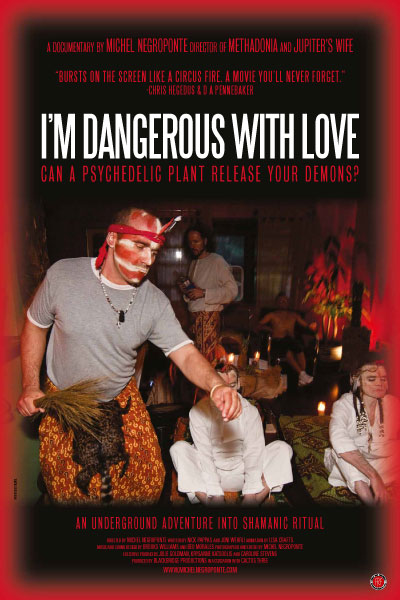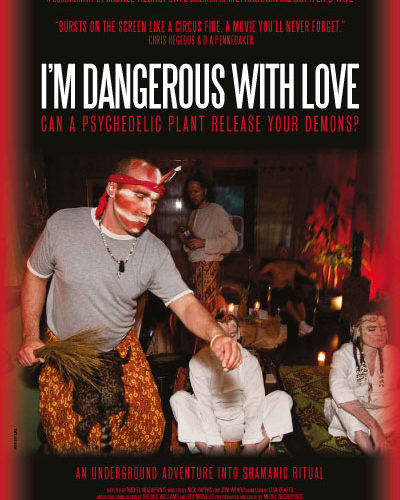 Can an illegal psychedelic substance cure drug addiction? This is the curious question that filmmaker Michel Negroponte asks at the start of his documentary I’m Dangerous With Love. This doc exposes the underground practice of flooding an addict’s system with Ibogaine, a hallucinogen from West Africa that is said to break one’s body from its dependence of drugs without the devastating steps of withdrawal. This “miracle detox” cure seems too good to be true, but those expecting a thorough investigation into this use of the drug and its results will be sorely disappointed. I’m Dangerous With Love never introduces science or medical professionals into the proceedings. Instead, Negroponte follows one of Ibogaine’s most vocal U.S. promoters, Dimitri Mugianis, a former junkie/rock band frontman who is now a self-made “Ibogaine provider.”
Can an illegal psychedelic substance cure drug addiction? This is the curious question that filmmaker Michel Negroponte asks at the start of his documentary I’m Dangerous With Love. This doc exposes the underground practice of flooding an addict’s system with Ibogaine, a hallucinogen from West Africa that is said to break one’s body from its dependence of drugs without the devastating steps of withdrawal. This “miracle detox” cure seems too good to be true, but those expecting a thorough investigation into this use of the drug and its results will be sorely disappointed. I’m Dangerous With Love never introduces science or medical professionals into the proceedings. Instead, Negroponte follows one of Ibogaine’s most vocal U.S. promoters, Dimitri Mugianis, a former junkie/rock band frontman who is now a self-made “Ibogaine provider.”
Mugianis is an absolutely charismatic figure. He talks passionately and poetically about his low points and his faith in the Ibogaine cure. The problem here is that the filmmaker is too easily taken in by this man of magnetism. The film quickly shifts from an exploration of this underground (read: illegal) procedure to a wistful travel log of Mugianis’s journey to treat others. Together the pair travels from New York City to Mexico and Canada “curing” addicts as they go. Negroponte is so entranced by Mugianis’s conviction that he fails to ask pertinent questions. Mugianis claims he has medical professionals on-call in case of trouble, but as the drug is illegal he can’t speak about them. Negroponte takes Mugianis’s word as Gospel and we never see these mysterious medicine men or look for any other source on this drug and its treatment. It’s never revealed how the drug works or its effects on the body. And while it’s mentioned several times that people have died from this treatment, which is carried out without medical professionals present, Negroponte never explores the dark side of the drug or why these deaths occurred. Even when one of Mugianis’s clients nearly dies, Negropointe lists a few possibilities as to why the man stopped breathing, but then monotonely states through narration, “We may never know what really happened.” After nearly killing this client, Mugianis momentarily wonders aloud if he should stop providing Ibogaine treatments. Instead he decides he needs more “training,” but rather than boning up on the medical knowledge of the powerful drug that he spoon feeds to the addicted, he travels to Africa to explore its cultural and spiritual roots. He returns invigorated. And though he has no new knowledge of the risks of the drug, he now adds face paint and tribal dancing to his treatments. While I do believe that Mugianis wholeheartedly wants to save people who are as tortured by their drug addiction as he was, I’m not convinced this “cure” is all he believes it to be.
I’m Dangerous With Love is in fact dangerous. The director’s irresponsible choice to focus on the spiritual history of the drug while excluding any scientific data disturbed me. My major concern is that viewed by someone suffering from addiction, the distinction between the exploration of a so-called “miracle” cure and the journey of its willful American practitioner may be missed. The word “miracle” is thrown about a lot, which makes me wary. Seeing so many people fearful of the painful withdrawal inherent in heroin addiction, it’s easy to understand the allure of Mugianis’s approach, even if sometimes someone mysteriously dies. The promise of a painless cure may be a miracle, whether Mugianis’s treatment is that miracle remains to be seen. How does it work? What are the statistics of success and of death? Is part of its seeming effectiveness psychosomatic or is it chemistry? These are all questions Negroponte fails to ask much less answer. Ultimately, I’m Dangerous With Love is a troublesome tale of a well-intentioned self-made shaman whose “miracle” cure is as mysterious it is enticing.
I’m Dangerous With Love opens January 12, 2011.


